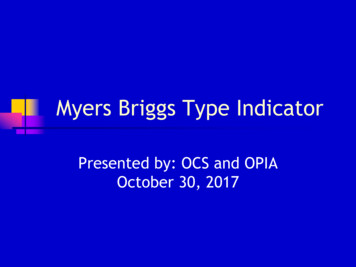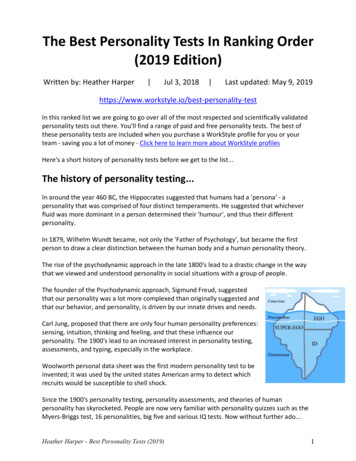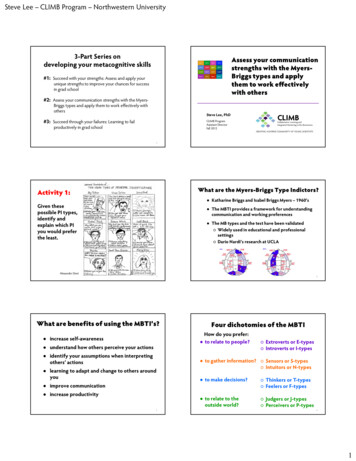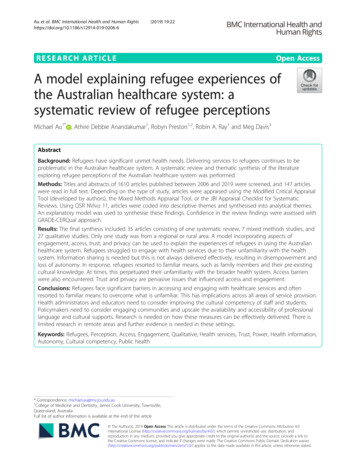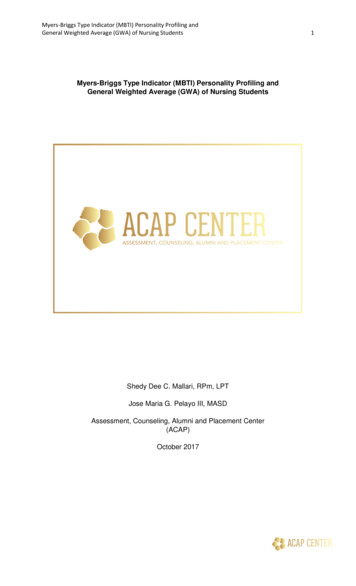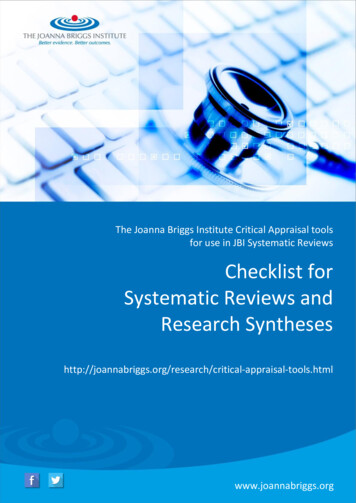
Transcription
The Joanna Briggs Institute Critical Appraisal toolsfor use in JBI Systematic ReviewsChecklist forSystematic Reviews andResearch -appraisal-tools.htmlwww.joannabriggs.org
The Joanna Briggs InstituteIntroductionThe Joanna Briggs Institute (JBI) is an international, membership based research and developmentorganization within the Faculty of Health Sciences at the University of Adelaide. The Institute specializesin promoting and supporting evidence-based healthcare by providing access to resources forprofessionals in nursing, midwifery, medicine, and allied health. With over 80 collaborating centres andentities, servicing over 90 countries, the Institute is a recognized global leader in evidence-basedhealthcare.JBI Systematic ReviewsThe core of evidence synthesis is the systematic review of literature of a particular intervention,condition or issue. The systematic review is essentially an analysis of the available literature (that is,evidence) and a judgment of the effectiveness or otherwise of a practice, involving a series of complexsteps. The JBI takes a particular view on what counts as evidence and the methods utilized to synthesizethose different types of evidence. In line with this broader view of evidence, the Institute has developedtheories, methodologies and rigorous processes for the critical appraisal and synthesis of thesediverse forms of evidence in order to aid in clinical decision-making in health care. There now existsJBI guidance for conducting reviews of effectiveness research, qualitative research,prevalence/incidence, etiology/risk, economic evaluations, text/opinion, diagnostic test accuracy,mixed-methods, umbrella reviews and scoping reviews. Further information regarding JBI systematicreviews can be found in the JBI Reviewer’s Manual on our website.JBI Critical Appraisal ToolsAll systematic reviews incorporate a process of critique or appraisal of the research evidence. Thepurpose of this appraisal is to assess the methodological quality of a study and to determine the extentto which a study has addressed the possibility of bias in its design, conduct and analysis. All papersselected for inclusion in the systematic review (that is – those that meet the inclusion criteria describedin the protocol) need to be subjected to rigorous appraisal by two critical appraisers. The results of thisappraisal can then be used to inform synthesis and interpretation of the results of the study. JBI Criticalappraisal tools have been developed by the JBI and collaborators and approved by the JBI ScientificCommittee following extensive peer review. Although designed for use in systematic reviews, JBI criticalappraisal tools can also be used when creating Critically Appraised Topics (CAT), in journal clubs and asan educational tool. Joanna Briggs Institute 2017Critical Appraisal Checklist 2for Systematic Reviews and Research Syntheses
JBI Critical Appraisal Checklist for Systematic Reviews and ResearchSynthesesReviewerDateAuthorYear1.Is the review question clearly and explicitly stated?2.Were the inclusion criteria appropriate for the reviewquestion?3.Was the search strategy appropriate?4.Were the sources and resources used to search forstudies adequate?5.Were the criteria for appraising studies appropriate?6.Was critical appraisal conducted by two or morereviewers independently?7.Were there methods to minimize errors in dataextraction?8.Were the methods used to combine studies appropriate?9.Was the likelihood of publication bias assessed?10. Were recommendations for policy and/or practicesupported by the reported data?11. Were the specific directives for new researchappropriate?Overall appraisal:Include Exclude Record NumberYesNoUnclearNotapplicable Seek further infoComments (Including reason for exclusion) Joanna Briggs Institute 2017Critical Appraisal Checklist 3for Systematic Reviews and Research Syntheses
JBI Critical Appraisal Checklist for Systematic Reviews and ResearchSynthesesHow to cite: Aromataris E, Fernandez R, Godfrey C, Holly C, Kahlil H, Tungpunkom P. Summarizingsystematic reviews: methodological development, conduct and reporting of an Umbrella reviewapproach. Int J Evid Based Healthc. 2015;13(3):132-40.When conducting an umbrella review using the JBI method, the critical appraisal instrument forSystematic Reviews should be used.The primary and secondary reviewer should discuss each item in the appraisal instrument for eachstudy included in their review. In particular, discussions should focus on what is consideredacceptable to the aims of the review in terms of the specific study characteristics. When appraisingsystematic reviews this discussion may include issues such as what represents an adequate searchstrategy or appropriate methods of synthesis. The reviewers should be clear on what constitutesacceptable levels of information to allocate a positive appraisal compared with a negative, orresponse of “unclear”. This discussion should ideally take place before the reviewers independentlyconduct the appraisal.Within umbrella reviews, quantitative or qualitative systematic reviews may be incorporated, aswell as meta-analyses of existing research. There are 11 questions to guide the appraisal ofsystematic reviews or meta-analyses. Each question should be answered as “yes”, “no”, or“unclear”. Not applicable “NA” is also provided as an option and may be appropriate in rareinstances.1. Is the review question clearly and explicitly stated?The review question is an essential step in the systematic review process. A well-articulatedquestion defines the scope of the review and aids in the development of the search strategy tolocate the relevant evidence. An explicitly stated question, formulated around its PICO(Population, Intervention, Comparator, Outcome) elements aids both the review team in theconduct of the review and the reader in determining if the review has achieved its objectives.Ideally the review question should be articulated in a published protocol; however this will notalways be the case with many reviews that are located. Joanna Briggs Institute 2017Critical Appraisal Checklist 4for Systematic Reviews and Research Syntheses
2.Were the inclusion criteria appropriate for the review question?The inclusion criteria should be identifiable from, and match the review question. The necessaryelements of the PICO should be explicit and clearly defined. The inclusion criteria should bedetailed and the included reviews should clearly be eligible when matched against the statedinclusion criteria. Appraisers of meta-analyses will find that inclusion criteria may includecriteria around the ability to conduct statistical analyses which would not be the norm for asystematic review. The types of included studies should be relevant to the review question, forexample, an umbrella review aiming to summarize a range of effective non-pharmacologicalinterventions for aggressive behaviors amongst elderly patients with dementia will limit itselfto including systematic reviews and meta-analyses that synthesize quantitative studiesassessing the various interventions; qualitative or economic reviews would not be included.3.Was the search strategy appropriate?A systematic review should provide evidence of the search strategy that has been used to locatethe evidence. This may be found in the methods section of the review report in some cases, oras an appendix that may be provided as supplementary information to the review publication.A systematic review should present a clear search strategy that addresses each of theidentifiable PICO components of the review question. Some reviews may also provide adescription of the approach to searching and how the terms that were ultimately used werederived, though due to limits on word counts in journals this may be more the norm in onlineonly publications. There should be evidence of logical and relevant keywords and terms andalso evidence that Subject Headings and Indexing terms have been used in the conduct of thesearch. Limits on the search should also be considered and their potential impact; for example,if a date limit was used, was this appropriate and/or justified? If only English language studieswere included, will such a language bias have an impact on the review? The response to theseconsiderations will depend, in part, on the review question.4.Were the sources and resources used to search for studies adequate?A systematic review should attempt to identify “all” the available evidence and as such thereshould be evidence of a comprehensive search strategy. Multiple electronic databases shouldbe searched including major bibliographic citation databases such as MEDLINE and CINAHL.Ideally, other databases that are relevant to the review question should also be searched, forexample, a systematic review with a question about a physical therapy intervention should alsolook to search the PEDro database, whilst a review focusing on an educational interventionshould also search the ERIC. Reviews of effectiveness should aim to search trial registries. Acomprehensive search is the ideal way to minimize publication bias, as a result, a wellconducted systematic review should also attempt to search for grey literature, or“unpublished” studies; this may involve searching websites relevant to the review question, orthesis repositories. Joanna Briggs Institute 2017Critical Appraisal Checklist 5for Systematic Reviews and Research Syntheses
5.Were the criteria for appraising studies appropriate?The systematic review should present a clear statement that critical appraisal was conductedand provide the details of the items that were used to assess the included studies. This may bepresented in the methods of the review, as an appendix of supplementary information, or as areference to a source that can be located. The tools or instruments used should be appropriatefor the review question asked and the type of research conducted. For example, a systematicreview of effectiveness should present a tool or instrument that addresses aspects of validityfor experimental studies and randomized controlled trials such as randomization and blinding– if the review includes observational research to answer the same question a different toolwould be more appropriate. Similarly, a review assessing diagnostic test accuracy may refer tothe recognized QUADAS1 tool.6.Was critical appraisal conducted by two or more reviewers independently?Critical appraisal or some similar assessment of the quality of the literature included in asystematic review is essential. A key characteristic to minimize bias or systematic error in theconduct of a systematic review is to have the critical appraisal of the included studies completedindependently and in duplicate by members of the review team. The systematic review shouldpresent a clear statement that critical appraisal was conducted by at least two reviewersworking independently from each other and conferring where necessary to reach decisionregarding study quality and eligibility on the basis of quality.7.Were there methods to minimize errors in data extraction?Efforts made by review authors during data extraction can also minimize bias or systematicerrors in the conduct of a systematic review. Strategies to minimize bias may include conductingall data extraction in duplicate and independently, using specific tools or instruments to guidedata extraction and some evidence of piloting or training around their use.8.Were the methods used to combine studies appropriate?A synthesis of the evidence is a key feature of a systematic review. The synthesis that ispresented should be appropriate for the review question and the stated type of systematicreview and evidence it refers to. If a meta-analysis has been conducted this needs to bereviewed carefully. Was it appropriate to combine the studies? Have the reviewers assessedheterogeneity statistically and provided some explanation for heterogeneity that may bepresent? Often, where heterogeneous studies are included in the systematic review, narrativesynthesis will be an appropriate method for presenting the results of multiple studies. If aqualitative review, are the methods that have been used to synthesize findings congruent withthe stated methodology of the review? Is there adequate descriptive and explanatoryinformation to support the final synthesized findings that have been constructed from thefindings sourced from the original research? Joanna Briggs Institute 2017Critical Appraisal Checklist 6for Systematic Reviews and Research Syntheses
9.Was the likelihood of publication bias assessed?As mentioned, a comprehensive search strategy is the best means by which a review authormay alleviate the impact of publication bias on the results of the review. Reviews may alsopresent statistical tests such as Egger’s test or funnel plots to also assess the potential presenceof publication bias and its potential impact on the results of the review. This question will notbe applicable to systematic reviews of qualitative evidence.10. Were recommendations for policy and/or practice supported by the reported data?Whilst the first nine (9) questions specifically look to identify potential bias in the conduct of asystematic review, the final questions are more indictors of review quality rather than validity.Ideally a review should present recommendations for policy and practice. Where theserecommendations are made there should be a clear link to the results of the review. Is thereevidence that the strength of the findings and the quality of the research been considered inthe formulation of review recommendations?11. Were the specific directives for new research appropriate?The systematic review process is recognized for its ability to identify where gaps in the research,or knowledge base, around a particular topic exist. Most systematic review authors will providesome indication, often in the discussion section of the report, of where future researchdirection should lie. Where evidence is scarce or sample sizes that support overall estimates ofeffect are small and effect estimates are imprecise, repeating similar research to thoseidentified by the review may be necessary and appropriate. In other instances, the case for newresearch questions to investigate the topic may be warranted.References1. Whiting P, Rutjes AWS, Reitsma JB, Bossuyt PMM, Kleijnen J. The development of QUADAS:a tool for the quality assessment of studies of diagnostic accuracy included in systematicreviews. BMC Medical Research Methodology. 2003;3:25 doi:10.1186/1471-2288-3-25. Joanna Briggs Institute 2017Critical Appraisal Checklist 7for Systematic Reviews and Research Syntheses
JBI Critical Appraisal Checklist for Systematic Reviews and Research Syntheses How to cite: Aromataris E, Fernandez R, Godfrey C, Holly , Kahlil H, Tungpunkom P. Summarizing systematic reviews: methodological development, conduct and reporting of an Umbrella review approach. Int J Evid Based Healthc. 2015;13(3):132-40.


